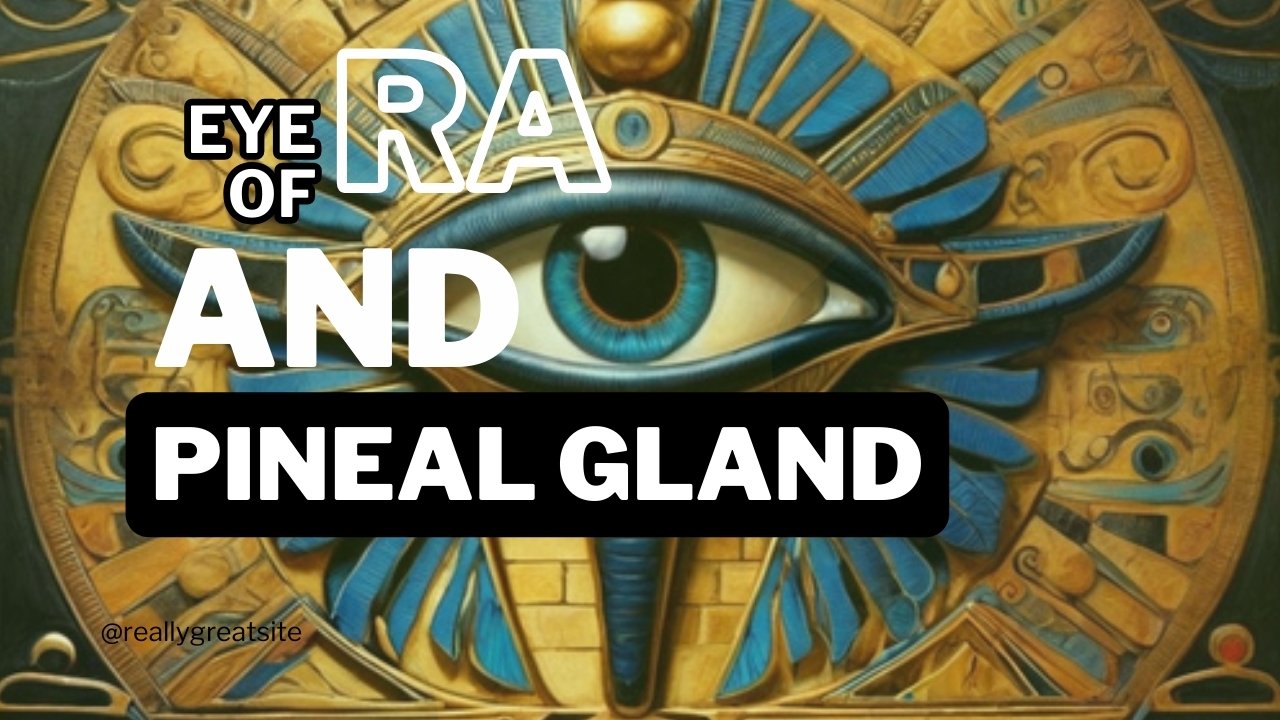In the esoteric realm, the “eye of Ra” holds profound symbolism – not just in the context of ancient Egyptian mythology but in relation to human physiology and spiritual exploration. At the heart of this symbolic union lies the intensely studied yet mysteriously understood organ within our brain – the pineal gland. For spiritual seekers and health enthusiasts alike, the intrigue around this convergence is more than mere curiosity; it’s a quest for a deeper understanding of our inner and outer worlds.
Is The Pineal Gland Truly The Third Eye? Unveiling The Mysteries
Countless Civilizations Across Time Have Revered The Pineal Gland As The “Seat Of The Soul” And, More Popularly In New Age Circles, As The “Third Eye.” But What Substantiates Such Grandiose Titles?

The pineal gland, located near the center of the brain, is a pea-sized endocrine organ with a complex web of photoreceptors similar to those in our eyes. It synthesizes and secretes melatonin, the hormone that regulates our sleep-wake cycle. It’s the only part of the human brain that’s not bilaterally symmetrical, resembling an eye remarkably. But is it the third eye as many claim?
Neuroscientists understood the pineal gland as a regulator of the circadian rhythm, with little regard for its spiritual significance. However, with the rising interest in holistic health and spirituality, researchers are revisiting its role, drawing parallels between pineal function and spiritual experiences.
What Does The Symbolism Of The Third Eye Truly Stand For?
To discern the symbolic relevance of the third eye, it’s paramount to trace its representation across various cultures. Often depicted as a metaphor for inner vision, intuition, and the gateway to higher consciousness, the third eye in Hinduism is associated with the Ajna chakra, symbolizing perception beyond ordinary sight.
Equally pivotal is its connotation in Buddhism, signifying the enlightened state attained through meditation and spiritual practice. The concept of clairvoyance and expanded insight is shared in Taoism, where the third eye leads to spiritual clarity.
Eye of Horus and Its Proximity To The Pineal Gland
The eye of Horus, or the “Wadjet Eye,” is an ancient Egyptian symbol that represents protection, health, and restoration. When placed alongside the brain’s anatomy, the eye of Horus aligns strikingly with the location of the pineal gland. This parallelism has led many to surmise that the eye of Horus hinted at the pineal’s role beyond physiological functions, possibly indicating a path to divinity.
The Pineal Gland and The Eye of Ra: Two Sacred Visions Aligned
Whereas the eye of Horus is often associated with healing and protective qualities, the “Eye of Ra” is linked with the sun god’s power and far-sightedness. This all-seeing eye, often depicted radiating light, could be considered a cosmic analog to the pineal gland, with both entities projected as a divine keystone within their respective contexts of anatomy and ancient spiritual mythos.
Unraveling The Third Eye-Pineal and Pituitary Gland Parallels
While the pineal gland’s association with the third eye is predominant, it’s integral to consider the pineal and pituitary glands as a synergistic unit. The pituitary gland, nestled within the sella turcica at the base of the brain, is often referred to as the “master gland” due to its crucial role in overseeing hormone function.
Together, the pineal and pituitary glands are thought to regulate multiple bodily functions while also potentially acting as conduits to higher consciousness. This harmonious relationship proposes a more intricate paradigm in understanding the third eye’s physiology and function.
Deciphering The Meaning of The Third Eye in Modern Contexts
In contemporary terms, the third eye symbolizes an awakened state of perception. Practitioners of yoga and meditation harness techniques to stimulate this center, believing it to be a reservoir of psychic potential and spiritual insight. The pursuit of “third eye activation” has become a multifaceted movement, bridging science, holistic wellness, and spiritual evolution.
Is The Eye of Horus Truly Representative of The Pineal Gland?
The debate continues among scholars and spiritual enthusiasts regarding the extent to which the eye of Horus reflects knowledge of the pineal gland. Skeptics argue that the ancient Egyptians might not have possessed the anatomical understanding to make such a direct association. However, proponents cite the Egyptians’ astrological wisdom and their connection to solar deities as potential indicators of a more profound awareness.
The Astonishing Relationship Between The Pineal Gland and The Retina
A groundbreaking discovery in 2002 featured the resemblance of the inside of the eye to the outside of the pineal gland. This finding implies a potential phototransduction pathway within the pineal gland, akin to how the retina responds to light. This revelation renews the discourse around the pineal gland’s role in light-sensitive processes and gazes.
Unveiling The Pineal Gland's Hidden Functions Beyond Melatonin Secretion
While the role of the pineal gland in melatonin production has been extensively documented, its other functions remain marginally understood. Speculations about its involvement in DMT synthesis, known as the “spirit molecule,” open up a realm of inquiry into its potential influence on mystical experiences.
Pineal Gland and The Eye of Ra in Regulating Synchronicity
The concept of synchronicity, advanced by Swiss psychologist Carl Jung, suggests a meaningful connection between the individual’s mind and the external environment. Intriguingly, the pineal gland’s role in decoding and processing psychic energy aligns with the “all-seeing” attribute of the Eye of Ra as an internal regulator of meaningful coincidences and spiritual epiphanies.
Stories of Activating The Eye of Horus
Accounts of ancient Egyptian initiates and the spiritual rites they undertook to activate the Eye of Horus provide a lens into the possible methods for stimulating the pineal gland. These practices, often shrouded in mystery and cautious secrecy, included sound vibrations, ceremonial anointing, and exposure to specific frequencies of light and darkness.
Uniting The Pineal Gland with Other Ancient Spiritual Traditions
The convergence of the pineal gland with symbols and practices from diverse spiritual customs suggests a shared lineage of knowledge concerning the inner sanctum of human spirituality. From the Vedas to the Pyramids, the pineal gland is presented as an instrument through which the seeker can transcend the physical and glimpse the celestial.
Implementing Pineal Gland Activation in Spiritual Growth
For those on the path of spiritual development, the concept of pineal gland activation resonates on a deeply personal level. While the specifics of how to awaken the third eye remain elusive, the pursuit often includes dedication to meditation, a harmonious lifestyle, and exploration of consciousness-altering techniques.
Practical Steps to Cultivate The Third Eye's Powers
Cultivating the potential of the third eye is an individual voyage marked by patience and exploration. Simple actions such as maintaining a healthful diet, practicing meditation, adopting light and sound therapy, and engaging in holistic practices can align your energy centers and potentially activate the pineal gland.
Pineal Gland Studies at The Vanguard Of Spiritual Science
With advancing technology and a more receptive scientific community, the study of the pineal gland is entering a new era. Magnetic resonance imaging (MRI) and activation techniques are shedding light on its response to stimuli, fostering a transcendent dialogue between empirical research and spiritual doctrine.
Common Myths and Misunderstandings About The Third Eye
The realm of the third eye is susceptible to misconceptions, misinterpretations, and exaggerated claims. One of the most common fallacies is the rapid and unsupervised pursuit of third eye activation through unverified methods, leading to discomfort and disorientation rather than enlightenment.
Integrating Its Significance into Modern Wellness Paradigms
The integration of the pineal gland’s significance into modern wellness paradigms is a pivotal step in reconciling science with spirituality. Health professionals, holistic practitioners, and spiritual guides play a crucial role in disseminating balanced and informed perspectives on the third eye’s potential and the measures to nurture it responsibly.
In Conclusion-The Divine Relationship Between The Eye of Ra and The Pineal Gland
The symbiotic resonance between the eye of Ra and the pineal gland evokes an intricate web of connections between the celestial and the corporeal. Its implications for spiritual ascent, higher perception, and holistic health underscore the urgency of unraveling its enigma responsibly and collectively.
While the third eye is a deeply ingrained concept in various spiritual traditions, its scientific validity remains an ongoing subject of study and debate. The pineal gland’s role as a regulator of circadian rhythms and melatonin secretion is well-established within the realm of neurobiology, with research expanding to explore its other potential functions.
Responsible pineal stimulation often comprises holistic practices such as meditation, exposure to natural light, and maintaining a healthy lifestyle. Engaging in these activities mindfully and gradually can foster the conditions for potential activation.
While there are no direct health risks associated with third eye activation, it’s essential to approach any consciousness-altering practice with caution and under the guidance of experienced practitioners. Unsupervised and rapid methods of activation can lead to discomfort and may not yield the desired spiritual benefits.
The potential enhancement of psychic abilities through pineal gland activation remains speculative and outside the realm of current scientific understanding. While the third eye has long been associated with heightened perception, the extent to which the pineal gland contributes to such abilities is open to interpretation.
Exploring the ancient mythos of the Eye of Ra alongside modern research on the pineal gland offers a comprehensive understanding of their interplay. Engaging with literature, documentaries, and academic papers focused on Egyptology, neurobiology, and spiritual philosophy can illuminate this transcendent association.








